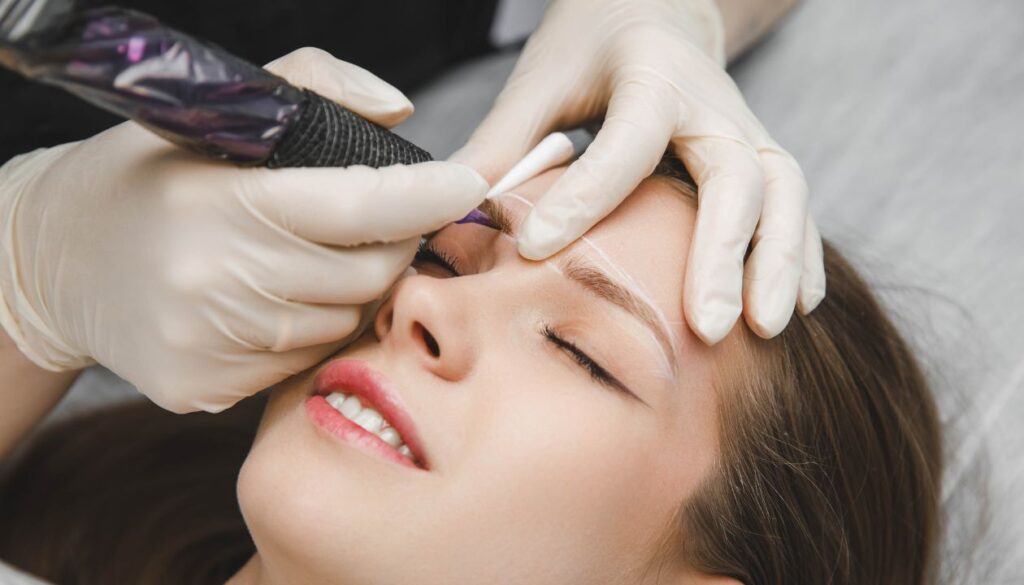If you’ve ever dreamed of having perfectly shaped, fuller eyebrows without the daily hassle of makeup, microblading might be the answer. This innovative cosmetic procedure uses a manual handheld tool with tiny needles to create hairlike strokes in your brows, giving you a natural yet polished look.
Before diving into the process, a licensed technician will consult with you to determine your desired brow style, taking into account your natural eyebrow color and facial features. Whether you prefer a soft, natural finish or a bold statement, microblading can be tailored to fit your unique aesthetic.
Get ready to explore the world of microblading and discover how it can transform your brows into a work of art.
What Is Microblading?
Microblading is a semipermanent cosmetic procedure that uses a handheld tool to create the appearance of fuller, precisely shaped eyebrows.
This technique involves tiny needles that form a small blade, allowing the professional to etch hairlike strokes into your skin while depositing pigment. The result mimics natural brow hairs and provides a realistic aesthetic.
Different styles of microblading are available, including microshading and microfeathering. Microshading provides a softer, fuller look similar to a filter effect, while microfeathering focuses on creating delicate, hairlike strokes for a more natural appearance.
Your specific choice depends on your personal preferences and desired outcomes, emphasizing the importance of consultation prior to the procedure.
The Microblading Process
Understanding the microblading process helps ensure a successful outcome. This procedure involves preparation, the actual microblading steps, and essential aftercare to maintain your new brows.
Preparation for Microblading
Preparation enables optimal results during microblading. Schedule your appointment with a licensed technician and clarify how to prepare. Many artists recommend refraining from grooming your brows for 6-8 weeks for proper reshaping.
Avoid using retinol, chemical exfoliants, or physical exfoliators at least one week before your appointment, as these can increase skin sensitivity. Additionally, steer clear of blood-thinning substances like aspirin or vitamin E 48 hours prior, and skip caffeine on the day of the procedure.
If you’re on antibiotics, wait 14 days after your last dose since these can alter pigment color during healing.
The Procedure
The microblading procedure requires precision and care. Your artist will start with a thorough consultation to discuss color options and style preferences, so bring inspiration images.
After applying a topical numbing cream to reduce discomfort, they typically let it sit for 30 minutes. Then, the technician will draw your desired brow shape using a dark pencil.
Once you’re satisfied with the shape, the technician will use a microblading tool—equipped with tiny needles—to create fine cuts in the skin, depositing pigment to mimic natural hairs. This process often involves multiple rounds of numbing and adjustments for the best results.
Aftercare Instructions
Aftercare is vital for preserving your new brows. Follow your technician’s specific aftercare instructions diligently.
Generally, avoid wetting your brows for 10 days after the procedure. Refrain from using makeup, creams, or any products on the brow area during this time.
Expect some scabbing, which is normal and should not be picked. Limit sun exposure to prevent fading and consult your technician if any unusual reactions occur. Following these guidelines ensures your brows heal properly and maintain their beauty.
Benefits of Microblading
Microblading offers several benefits that enhance your beauty routine.
- Immediate Results: You see noticeable results immediately after your appointment. While some swelling may occur during the healing phase, the difference in your eyebrows is apparent right away.
- Convenience: Microblading eliminates the daily hassle of drawing or filling in your eyebrows. This saves significant time in your morning routine.
- Improved Appearance: Eyebrows play a crucial role in facial expression and beauty. Microblading creates fuller, well-defined brows that frame your face and enhance your natural features.
- Long-Lasting Results: Microblading results last from one to three years, depending on your skin type and lifestyle. Oily skin tends to fade the ink faster, but overall, the longevity reduces your need for frequent touch-ups.
- Painless Procedure: Compared to other eyebrow tattooing methods, microblading is relatively painless. The use of a numbing agent minimizes discomfort during the process.
Who Is a Good Candidate for Microblading?
A good candidate for microblading isn’t determined solely by the quantity of natural brow hair. Instead, it relies heavily on your skin type. If your skin is super reactive or sensitive, microblading may not be suitable for you.
Individuals with keratosis pilaris on the forehead or those with consistent breakouts or cystic acne around the brow area may also face challenges with this procedure. Initial inflammation from microblading can worsen these skin conditions, affecting the healing process.
Oily skin can further complicate microblading outcomes. Excess oil may cause the pigment to fade more quickly, reducing the longevity of your results.
Not everyone qualifies for microblading. You’re not a suitable candidate if you meet any of the following criteria:
- You’re pregnant or nursing.
- You’re under 18 years of age.
- You’ve had an organ transplant.
- You currently have a viral infection or disease.
- You have major heart problems or require a pacemaker.
- You have a preexisting skin condition on or near the eyebrows.
- You’re allergic to metal or specific dyes.
- You have an autoimmune condition, such as Lupus or Multiple Sclerosis.
- You’re currently on Accutane or have taken it within the past 12 months.
Consulting with a technician is essential to assess your candidacy. Each client’s situation is reviewed on a case-by-case basis, ensuring personalized recommendations.
If you have concerns about eligibility, discussing them directly with the salon technician provides clarity and guidance.
Conclusion
Microblading offers a fantastic way to enhance your eyebrows with a natural look that lasts. By choosing a skilled technician and following proper aftercare, you can enjoy beautifully shaped brows without the daily hassle of makeup.
While it’s essential to weigh the benefits against potential drawbacks, understanding your skin type and consulting with a professional can help you make the right choice. If you’re seeking a low-maintenance beauty solution that boosts your confidence, microblading might just be the perfect fit for you. Embrace the opportunity to redefine your brows and enjoy the convenience of effortless beauty.
Frequently Asked Questions
Do they shave your eyebrows for microblading?
No, technicians do not shave your eyebrows for microblading. Instead, they may trim or shape the existing hairs to create a clean canvas for the procedure. This helps achieve the best results without compromising your natural brows.
What happens to your real eyebrows after microblading?
Your real eyebrows will remain intact after microblading. The procedure enhances the appearance of your brows by adding pigment and shape, but your natural hairs will continue to grow as usual. Regular maintenance might be needed to keep the desired shape.
Is microblading out of style in 2024?
Microblading remains popular in 2024 as it offers a natural-looking solution for fuller brows. While brow trends change, microblading continues to appeal due to its semi-permanent nature and ability to create realistic hair-like strokes.
Who should avoid microblading?
Individuals with reactive or sensitive skin, certain skin conditions, or allergies, as well as those who are pregnant or nursing, should avoid microblading. It’s essential to consult a licensed technician to determine if you’re a suitable candidate.
What if you don’t like your microblading eyebrows?
If you’re unhappy with your microblading, first reach out to your technician for adjustments or corrections. If dissatisfaction persists, consider removal options like saline or laser treatments to address unwanted results effectively.
Love It or Lose It: Elevate Your Brows with Microblading
Thinking about microblading? Love It or Lose It offers professional microblading services to help define and enhance your brows.
Whether you’re looking for a fuller appearance or a subtle shape boost, we’ll work with you to create a look that suits your style. Book your appointment today and take the first step toward effortless, well-shaped brows!


